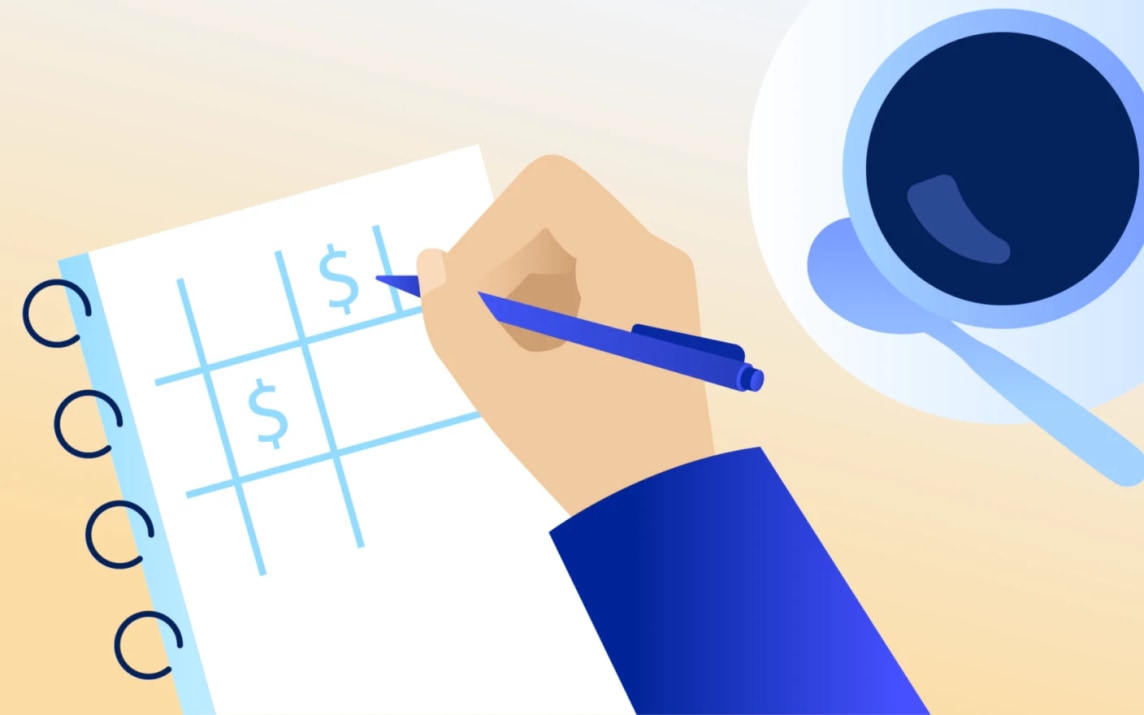Common budgeting methods
A budget helps you plan your approach to spending each month so that you can be in better control of your money. Below are some of the common budgeting systems you can follow.
50/30/20 rule
The 50/30/20 rule guides you on how to save and spend money. The 50/30/20 method is a simplified, easy form of budgeting where spending in key categories of expenses is limited to a percent of your after-tax income. With the 50/30/20 rule, you break your monthly income into three categories: needs, wants, and savings, as outlined below.
Needs: 50% of your after-tax income covers your living expenses. This includes your rent or mortgage payments, utilities, groceries, minimum loan payments, and insurance.
Wants: 30% of your monthly income should go towards discretionary expenses, such as dining out, subscriptions, and travel. Wants are nice to have, but you can live without them.
Savings: You should aim to save 20% of your after-tax income. Savings can mean depositing money into an emergency fund, making retirement contributions to your 401(k), or paying off debt. Ultimately, this 20% can be a mix of both debt paydown and savings.
70/20/10 rule
The 70/20/10 rule follows a similar path — you allocate your monthly income into three buckets: living expenses, savings, and debt. Under this rule, however, you can sock away more money for savings or debt reduction.
Expenses: Under this rule, both your needs and wants should make up no more than 70% of your monthly income. This should include your rent, utilities, and entertainment costs.
Savings: 20% of your after-tax income can be saved by making contributions to your retirement fund, setting money aside for your emergency fund, or reserved for future use.
Debt: 10% of after-tax income should go toward paying off debt like credit cards, student loans, or car loans.
Envelope budgeting
Envelope budgeting is an all-cash budgeting approach. Once you decide how much you’ll spend on each budget category, put that amount of cash into an envelope earmarked for that expense. Every time you buy something that falls under that category, you'll use the money in that envelope.
Some people may find it easier to manage their money when they can physically see it. However, there are digital platforms that mimic envelope budgeting without the need to put cash in envelopes.
Zero based budget
Every dollar you make is used in a zero-based budget. Using every dollar doesn’t mean spending it; instead, a zero-based budget puts every dollar you earn to work. Like many other budget approaches, you start with listing all of your income and then subtracting monthly expenses. You can divide those expenses into categories such as rent, food, transportation, and entertainment. However, you’ll also budget for other financial goals, such as paying off debt or saving money. If you get to the end of the month with a surplus, you can assign it to savings or roll it into next month's budget. Ultimately, you assign a category for every dollar earned.
“Pay yourself first” budget
The purpose of any budget is to keep more of your money. With the “pay yourself first” method, you put aside the amount you choose to save each month before spending any of your earnings. Then, you may live off whatever money is left. Like many other budget methods, you will still need to know how much your living expenses cost. However, the key difference with the “pay yourself first” approach is its emphasis on saving before spending. Although every situation is different, saving at least 10% of income is a common approach.
A simple approach to budgeting
Budgeting does not have to be a complicated mess of numbers. Instead, focus on one area of your budget at a time. When you break down the pieces of your budget into smaller bites, putting together your personal finance budget becomes far more manageable.
You can learn how to make a budget by following a few simple steps listed below.
Step 1: Determining your monthly income
Your monthly income is money you expect to receive during the month. Income typically includes your paycheck and additional sources of revenue.
Your budget is based on how much money you make each month. To get an idea of your monthly income, look through your bank statements or online accounts. Add up what is deposited into your bank account through paychecks, benefit payments, or any other income you receive on a monthly basis.
Step 2: Tally up your monthly expenses
For better control over your money, you need to know where it goes. Therefore, listing all expenses from your bank statement or online accounts is a good way to get an idea of what you spend each month. Here are a few things to keep in mind regarding your expenses:
Fixed expenses stay the same every month. A fixed cost includes your rent payment or insurance premium. Fixed costs do not vary, so they are easier to quantify.
Variable costs, such as groceries or gasoline, could change monthly. Variable costs can be different from month to month, so it’s best to determine a 3 to 6 month average, at minimum.
Start listing essential living expenses to get an idea of your monthly expenses. Everyday living expenses include food, your rent or mortgage payment, utilities, childcare, and insurance. Next, list all-nonessential costs, such as monthly subscriptions, entertainment, or dinners out.
As you write down your monthly expenses, take this opportunity to determine how much you plan to save and how much debt you plan to pay off each month. Once you’ve listed out what you plan to pay each month, it is time to add up your monthly expenses.
Step 3: Subtract your expenses with your income
The next step is to subtract your monthly expenses from your monthly income. Once you’ve done this, you should end up at zero. When your monthly income covers all your budgeted costs, this shows that every dollar you earn is being spent the way you intend.
Look closely at your budget line items if you spend more than you make. Consider cutting back on non-essentials, like eating out or monthly subscriptions you can live without. While cutting out these extras may seem rough, keep in mind that you shouldn’t spend more than you make.
If you have money left over, be sure to put it to good use! Consider putting it toward your emergency fund or paying off debt.
Step 4: Identify opportunities to lower costs
Seek ways to cut down on what you spend each month. For example, try cutting out unused monthly subscriptions for services you no longer need or use. You can also cut down on your interest payments by transferring higher credit card debt to a lower-interest credit card. Then, you can put those funds to better use. Whether your cost savings helps you pay off more debt, bumps up your retirement contribution, or goes toward your emergency fund, cutting back on your expenses will help you reach your financial goals faster.
Important budgeting tips
Budgeting is a valuable tool for executing a successful financial plan. Here are some tips to consider when designing and implementing your budget.
Set tangible goals. A budget can be your roadmap to financial freedom. But you need to set tangible goals to get there. Turn your vague goal of saving money into something quantifiable, like saving $10,000 toward a down payment for a new home.
Save for retirement. Even if retirement is years away for you, it’s never too early to start saving. If your employer matches your contributions, you can easily double your savings.
Build an emergency fund. Emergencies happen, but the unexpected doesn’t have to drain your finances if you’re prepared. Plan ahead for unforeseen car repairs or medical bills by putting money into an emergency fund.
Pay off high-interest debt. High-interest debt can cost you hundreds of dollars in interest every year, but when you focus on paying down debt that carries a high-interest rate, such as credit cards, you free up your cash flow by avoiding interest rate fees.
Use cash. Consider using physical cash for budget items where you constantly overspend, such as dining out. Sticking with cash rather than relying on credit card debt for these line items can help you stay within your limits. Once your cash is gone for the month, you have nothing more to spend and won’t go into debt.
Work with a financial advisor. You don’t have to come up with a budget alone! A financial advisor can help you with budgeting questions and devise a budgeting method that works for you.
A budget is a vital tool for managing your finances. Contrary to common belief, budgets are not focused solely on restricting how you spend your money. Instead, it’s helpful to see your budget as a plan. By giving each dollar you earn a job, you can take control over your financial future more efficiently.
If you need help choosing the best budgeting system for your household, our team at FinanceHQ can match you with an advisor to help you organize your finances and build a budgeting plan to achieve your financial goals.

